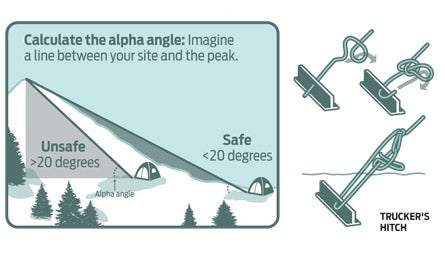Adventure Upgrade: Camp Comfortably in Winter

'Illustrations by Supercorn'
Reader Peggy Cleveland, 55, Cranford, NJ
» Problem “I almost got frostbite on a cold-weather campout, and we barely slept because we were so cold. I love being out in winter, but how do I pitch a tent in snow, and what should I expect from my gear when temperatures dip below 20°F?”
Expert R.L. Stolz , Alpine Adventures, Adirondack mountain guides
» Solution “Stay warm by picking the right spot to pitch your tent and making sure your gear is up for the conditions. Make your first-ever winter trips late in the season, when temperatures are typically milder and days are getting longer. The margin for error is larger.”
Pitch a Bomber Tent
Erect a shelter correctly—in the right spot, and secure against the worst weather.
» Pick a safe, warm site. Choose campsites away from cliff edges, avalanche slopes, and dead branches or trees (called widowmakers). Try to set up away from wind and low spots, where cold air settles. Determine if you’re too close to a potential avy runout by estimating the alpha angle, the angle between the top of a potential avalanche slope and your campsite. If the alpha angle is more than 20 degrees (see above left), don’t set up camp in that area.
» Pack the surface. While wearing skis or snowshoes, stomp out a platform about twice as large as your tent. Wait 30 minutes to one hour for the packed snow to harden (called sintering) enough to walk on. While you wait, dig out table surfaces for a cooking area, and pack down routes to a toilet and a water source.
» Stake it out. Use snow stakes (or improvise with rocks, sticks, snow-filled stuffsacks, or skis—anything that you won’t need to use while the tent is pitched) to secure tent corners and guylines. To set anchors: Pack a one-foot-deep hole in the snow where you want to place the stake and lay the anchor in the base of it. Fill the hole with snow and pack it to a level surface; the snow will settle and harden.
» Protect against wind. Pitch your shelter’s most aerodynamic end facing the wind. Tents are most wind-resistant when pitched tightly, so stake it securely and use a sliding knot like a trucker’s hitch (see above right) so you can retighten lines without having to reset anchors. If possible, position the door at a 90-degree angle to the wind to minimize access-blocking snowdrifts. Consider pitching behind a natural windbreak like a dense stand of trees, or building a wall of snow on the tent’s windward side. If your wall is three feet tall, build it three feet from your tent so drifts it collects don’t bury your shelter.
Sleep Warm
Rest well to weather cold days.
» Stay dry. Change into dry layers to sleep, brush off snow before entering your tent, and keep a small sponge on hand to wipe condensation off walls.
» Insulate. Don’t lose heat to the frozen ground. Layer a foam pad under an inflatable, or get a cold-weather pad like Kelty’s Recluse 2.5i ($80; kelty.com).
» Warm up. Pile on calories at dinner and snack before bedtime. For a warming boost snuggle with a hot-water-filled bottle and do a few sit-ups in your bag.
Keep Gear Frost-Free
Don’t lose performance in a deep freeze.
» Boots and gloves Put gloves and shoes and/or boot liners inside a stuffsack and keep the sack in your tent or sleeping bag footbox overnight.
» Water purification Leave pump filters at home; they may freeze and crack. Instead, use a chemical or UV treatment to purify or plan to melt snow for drinking. Note: Boiling water from clean snow isn’t necessary because snow doesn’t harbor gut-busting bacteria.
» Stove Bring a white-gas burner; the fuel performs better than canisters in temps below 40°F. Melting snow to drink? Pack at least 6 ounces of fuel per person, per day. Facing extreme temps? Carrying up to 15 ounces of fuel per person per day may be appropriate.
» Electronics Alkaline cells use water-based electrolytes that freeze at 32°F. Keep cells warm in your pockets or use lithium (which work down to -40°F).